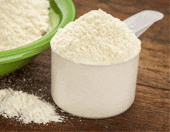Proteins Compared: Vegan vs. Traditional Sources
Proteins are the building blocks of our muscles, breaking down into amino acids and promoting muscle growth. With the rise of diets like veganism and vegetarianism, many people are beginning to seek out alternative sources. Consuming protein is part of any healthy diet, so we've outlined both traditional and vegan sources of protein, how they stack up nutritionally, and how you can incorporate each into your lifestyle.
Animal vs. Plant Protein
Animal products such as meat, eggs, and dairy are great sources of protein. However, they may also be high in LDL cholesterol and saturated fat. Because of this, some people may opt for a leaner source of animal protein, such as salmon. Others will use whey protein, a byproduct of cheese production, to obtain their daily recommended intake of protein.
Plants also provide protein. However, many fruits and vegetables lack one or two of the essential amino acids your body needs. Vegetarians and vegans must therefore find other sources of plant proteins, such as different varieties of beans, legumes, tofu, quinoa, nuts, and seeds, among others.
Nutritional Value
Animal-based and plant-based proteins provide different nutritional value to consumers. Some animal proteins are very high in saturated fat and low in dietary fiber, while plant proteins are high in fiber, but often lack one or two of the nine essential amino acids.
For example, a cut of steak will give you approximately 40 grams of protein, but it will also provide you with more than 60% of your recommended intake of saturated fat. Salmon, on the other hand, contains over 30 grams of protein and one-eighth of the saturated fat content of steak; it's also high in heart-healthy fats such as omega-3s.
Plant-based proteins tend to be lower in sodium and higher in fiber. For example, one cup of tempeh provides 31 grams of protein. Lentils give you 18 grams per cup. Black beans, chickpeas, and other beans provide approximately 15 grams per one cup.
The other thing to watch out for in animal proteins, especially pre-packaged and cured ones, is the sodium content. Additionally, consuming high amounts of animal protein such as red meat has been linked to many health issues such as cardiovascular disease, diabetes, and even cancer.

Protein Versatility
Because animal protein and plant protein differ, each offers something unique to our diets and must be treated differently when preparing them for meals. The good thing is that both sources of protein are extremely versatile. Add some grilled chicken to a salad or top your favorite savory breakfast bowl with an egg.
When it comes to plant-based protein sources, some people may want to make an almond butter to spread on whole wheat or even flax toast. You can also toss together a buckwheat salad or get adventurous with a spirulina smoothie.
When it comes to which protein source is better, it depends on your diet and whether the other foods you're eating balance each other. Each source has nutritional advantages and disadvantages, from amino acid profile to sodium content to fiber to saturated fats. Ultimately, you want to find a healthy protein source that you enjoy and that fits your lifestyle.

Photos: cookbookman17, Golubovy / Shutterstock.com, Jiri Hera / Shutterstock.com, Anna Hoychuk / Shutterstock.com
Healthy Eating
- Healthy Snacks
- Healthy Meals
- Healthy Recipes
- Sports Nutrition
- Nutrition and Special Diets
- 21 Day Fix
- 5 Popular Diet Similarities
- Alkaline Diet
- Anti-Inflammatory Diet
- Calorie Counting
- Carb Cycling Diet
- Celiac Disease
- Cholesterol
- Clean Eating
- Crohn's Disease
- DASH Diet
- Detox Diet
- Diabetes
- Diabetes Diet
- Diet Pill Dangers
- Fat Burning Foods
- Gluten-free Diet
- Glycemic Index
- Heart Health
- High Blood Pressure Diet
- High Fiber Foods
- How to Eat Healthy
- How to Lower Blood Pressure
- Hypertension
- IBS Diet
- Ketogenic Diet
- Liquid Diet
- Low GI Foods
- Low-Carb Diet and Foods
- Low-Fat High-Carb Diet
- Mediterranean Diet
- Mediterranean Diet Foods
- Military Diet
- Nutrition Labels Explained
- Paleo Diet
- Raw Food Diet
- Superfoods
- Sustainable Weight Loss
- Thrive Diet
- Vegan Diet
- Vegetarian Diet
- Weight Loss Shakes
- Whole30
- Vitamins, Minerals & Nutrients




